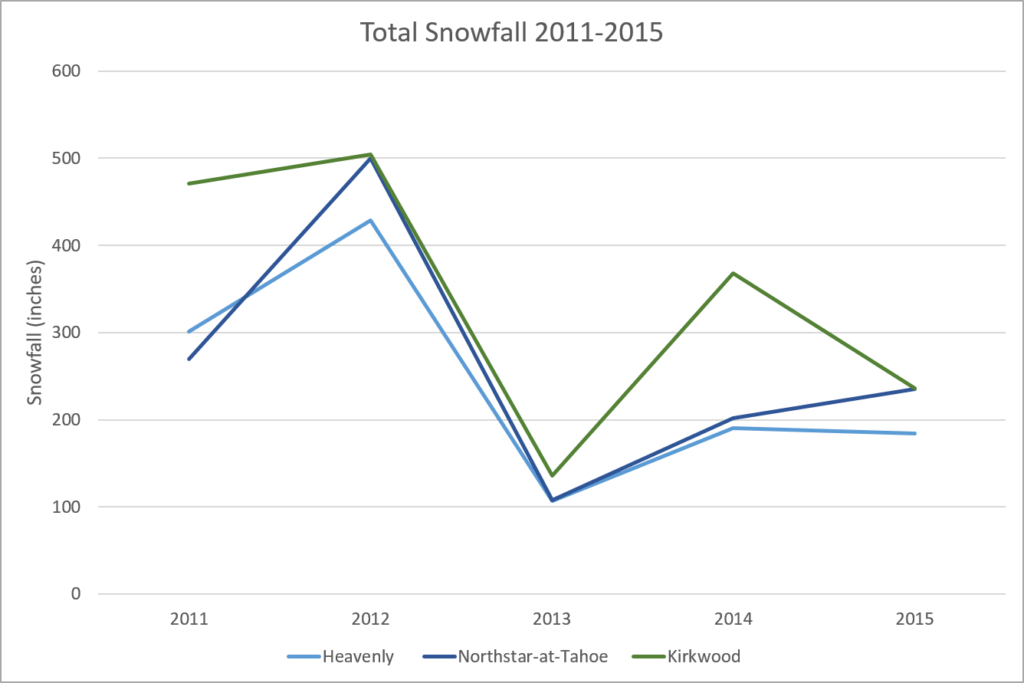Vail Resorts, Inc: The Cold Business of Beating Climate Change

The planet is getting warmer and ski resorts are not exempt. How can Vail Resorts, Inc. protect a business that relies on cold weather?
As the facts about climate change have become increasingly undeniable, companies from a variety of industries have begun to change their operations to adjust this new reality. Some industries have been affected more than others, but what happens when your business purely dependent on the weather for 7 months of the year? That’s the mountainous challenge that Vail Resorts, Inc. currently faces.
The Birth of a Winter Sport Superpower
Over the last six years, Vail Resorts has been extremely active in building its resort portfolio through M&A activity. Starting with the acquisition of Northstar-at-Tahoe in 2012 [1], Vail Resorts proceeded to acquire Kirkwood [2], Afton Alps, Mount Brighton [3], Canyons Resort [4], Park City Mountain Resort [5], Perisher Ski Resort [6], Wilmot Mountain [7], and capped it off with the recent acquisition of Whistler Blackcomb [8]. Through these acquisitions, Vail Resorts has positioned itself as the largest mountain resort ownership group in the United States [9].
During this period of rapid expansion, Vail has boosted its revenues from $1.02B in FY12 to $1.6B FY16 but it has not been limited to topline growth. The resort conglomerate has paired its impressive growth with its margins that increased from 1.61% to 9.35% during the same period [10].
Growing Cause for Concern
Despite these encouraging numbers, Vail Resorts still has cause for concern. Lake Tahoe’s ski area houses three of Vail Resorts’ larger mountains (Northstar-at-Tahoe, Kirkwood, and Heavenly) which have seen the dramatic effects of climate change on both the on both the amount of total snowfall (Figure 1) and their average base depth of snow over the course of the season (Figure 2). As can be seen in Exhibit 1, Heavenly, Northstar-at-Tahoe, and Kirwood have seen decreases in total snowfall of 39%, 13%, and 50% respectively from 2011 to 2015.
Figure 1
What may be an even more worrisome measure of the mountains’ suitability for skiing and snowboarding is the percent decrease in average base depth. These three resorts all showed a decrease of greater than 50% during this same time period [11]. Even in years like 2014 where total snowfall saw an increase across the board, the average base depth was still drastically lower than 2011. This signals that even if there are large amounts of snowfall, the temperature on the mountain isn’t staying cold enough for the snow to stick and it is simply melting away.
Figure 2
In addition to poor weather conditions, data shows that the number of snow resort visitors nationally has been decreasing since the 2010/2011 season, the same period where we have observed major climate change effects at the three mountains referenced above. While not all winter resorts have been impacted by the effect of climate change, these three resorts are emblematic of the problem that Vail Resorts is currently facing. This is clearly supported by the below data that shows after an all-time high in snowsport visitors in 2010/2011, visitors have fallen by 12.8% [12]. With guests being the lifeblood of a resort’s revenue, it’s critical that Vail Resorts take action to mitigate climate change to ensure continued success.
Figure 3
The Path to More Powder
Unsurprisingly, Vail Resorts is acutely aware of the problems that climate change poses for their business and has already begun making a concerted effort to become a more sustainable, eco-friendly collection of resorts. Between 2008 and 2011 Vail Resorts reduced their energy consumption by 10% and are targeting another 10% decrease by 2020. Additionally, the company has piloted a GPS system to monitor the efficiency of its snowcats (machines used to groom the mountain) to reduce the amount of fossil fuels used per acre of the mountain that is groomed [13].
One of Vail Resorts’ biggest rivals is Squaw Valley, another premier resort in the Lake Tahoe area. Despite their jockeying for position as Tahoe’s top destinations, Vail Resorts would be well served to implement some of the changes Squaw has put in action recently. Earlier this year, Squaw announced that it would be implementing a designated parking area for visitors who carpool to the mountain. Not only does this have the potential to save over 85,000 gallons of gas this upcoming season, it also makes logistics easier on the Squaw staff by reducing up to 657 vehicles from the road per day [14]. Squaw has also partnered with Tesla to implement a microgrid system at the resort for energy generation and storage that is projected to reduce energy consumption 30-60% [15].
Vail Resorts has a long road ahead of it but with sustainability implementation already in place and other models of improvement paving the path towards a smaller carbon footprint, the company can do its part to combat climate change and keep people skiing. [Word Count: 793]
References
[1] Miller, Scott, “Vail Resorts acquires Northstar-at-Tahoe”, 2010, [URL], accessed November 2016
[2] Vail Resorts Corporate, “Vail Resorts to Acquire Kirkwood Mountain Resort”, 2012, [URL], accessed November 2016
[3] Vail Resorts Corporate, “Vail Resorts to Acquire Two Ski Areas in Midwest, Afton Alps in Minnesota and Mount Brighton in Michigan”, 2012, [URL], accessed November 2016
[4] Holden, Will C., “Vail Resorts acquires long-term lease to Canyons, Utah’s largest ski resort”, 2013, [URL], accessed November 2016
[5] Vail Resorts Corporate, “Vail Resorts Acquires Park City Mountain Resort in Park City, Utah”, 2014, [URL], accessed November 2016
[6] Vail Resorts Corporate, “Vail Resorts Closes its Acquisition of Perisher, the Largest Mountain Resort in Australia”, 2015, [URL], accessed November 2016
[7] Keilman, John, “Sale to Vail Resorts may invigorate Wilmot Mountain”, Chicago Tribune, 2016, [URL], accessed November 2016
[8] Dmitrieva, Katia; Gopal, Prashant, “Climate change, currency swings spur Vail’s decision to buy Whistler”, Bloomberg News, 2016, [URL], accessed November 2016
[9] National Ski Areas Association Industry Stats, [URL], accessed November 2016
[10] Vail Resorts, Inc. 2016 Annual Report, [URL], accessed November 2016
[11] OnTheSnow.com historical snowfall database, [URL], accessed November 2016
[12] National Ski Areas Association Industry Stats, [URL], accessed November 2016
[13] Vail Sustainability Information, Vail.com, [URL], accessed November 2016
[14] Squaw Valley | Alpine Meadows Press Release, 2016, [URL], accessed November 2016
[15] Black, Jake, “Think Big, Part 2 | How Squaw Valley’s Partnership with Tesla May Be the Beginning of a New Energy Model”, 2016, [URL], accessed November 2016






Great post and scary future for skiing! You mentioned one of Vail’s main competitors is Squaw Valley and the actions they have taken. Squaw has also joined the National Ski Areas Associations Climate Change Challenge along with 36 other ski resorts.
You can check out their annual report here: http://www.nsaa.org/media/274957/2016_Climate_Challenge_Annual_Report.pdf The program is doing some really good things to combat climate change! The program helps make ski resorts drive towards actionable change though a five step process: 1) Inventory 2) Target 3) Reduce 4) Advocate 5) Report
I find it surprising Vail is not part of the Climate Change Challenge already and, to me, signifies they may have some less-than-ideal environmental practices in their operations that they do not intend to fix in the near future.
Really interesting article! I am surprised that, despite an unquestionably perilous exposure to the continued effects of climate change, Vail Resorts seems to be doing surprisingly little to stabilize its position (diversifying to other types of resorts, focusing on reducing emissions, etc). I think another interesting factor to consider is the degree to which Vail Resorts’ mountains have to make their own snow. Given that tha Tahoo region has been seeing much lower snowfall totals over the past years, it is reasonable to assume that their need for artificially produced snow has skyrocketed. This artificial snow, shot out from “snow guns” to cover ski trails is, in and of itself, a large source of carbon emissions. Thus, with less snow, mountains need to produce more of their own, and thereby increases its carbon emissions–creating quite a troubling cycle. Vail should invest in newer snow gun technologies that help reduce emissions, like the one discussed in the following WIRED article (https://www.wired.com/2015/02/how-to-make-fake-snow/).
Thank you so much for the fascinating read!
Great piece on the effects of climate change on ski mountains — agreed that reduced snowfall and thus fewer powder days would be a disaster! I agree with EBN above that it is odd that Vail is not a member of the NSAA, especially when Whistler, one of their properties, has pledged to be a member. I’m familiar with Jackson Hole and they identified a few actions to improve energy consumption, including improved carpooling, parking, and bussing systems with local government and upgraded all mountain vehicles (Jeeps and snowmobiles) to models with eco-friendly emissions (http://www.jacksonhole.com/e-energy.html). In addition, JH has bought renewable energy credits to 100% offset lift energy usage — perhaps given Vail’s improved margins, they could deploy some capital to reach emission neutrality across their resorts as well!
Glad to see that Vail is hedging its bets through new resort acquisitions (and shocked to see how concentrated the snow sport industry already is). However, I would caution against blindly adding in European ski destinations as part of a geographic diversification strategy for grappling with climate change. One of the more surprising facts I learned in reading up on climate change is that the Alps, unlike the younger U.S. Rockies, are held together in large part by permafrost. Take the Matterhorn for instance – that beautiful ridgeline you think you see actually has actually had an ever increasing rate of rock fall because of melting permafrost. Basically, the mountain is becoming unglued, creating new risks for businesses beneath the rock fall. Finding ways to diversify the length of the ski season is one thing – seeing the mountains fall down around your ears is another.
Having lived in the San Francisco Bay Area (and a fan of Northstar, Kirkwood and Heavenly), this issue is front and center to many avid skiers and snowboarders. From around 2011 onward the awareness of the reduced snowfall was widespread and has had a real impact on resort demand. This is a very difficult position to be in as a company, as the business is massively impacted by something out of their control.
Diversification is the clearest way to hedge against variation in snow volume, and we’ve seen Vail employ this strategy aggressively as mentioned in your post. Levers to pull at the resort level, however, are harder to come by. Artificial snow, as Mike describes in his comment above, is likely the most direct resource they have. Investment in new technologies in this space will be critical – more cost-effective machines with the capability to cover greater areas efficiently may serve to reassure consumers that their favorite slopes will be open when they arrive. Great read – thanks for the post!